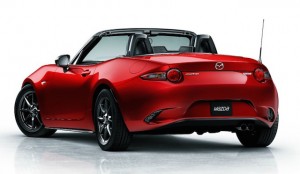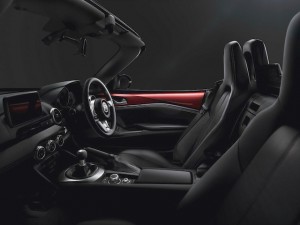
Mazda’s fourth-generation MX-5 appears to have stayed true to the lightweight roots of the 1989 original, despite the global legislative need these days for safety and emission requirements that add weight to almost every component.
The new MX-5 has been unveiled simultaneously at three global locations in Japan, USA, and Spain. Details are slim, other than it’s a product of Mazda’s Kodo design language and chockablock with SkyActiv technology, an energy-efficient package of high-compression engines, slick gearboxes, and lightweight chassis.
 It is also, says Mazda, the most compact of any generation MX-5 so far and more than 100kg lighter than the model it replaces, “promising a dramatic leap in Jinba-ittai driving fun.” The motto in creating the car was “Innovate in order to preserve.”
It is also, says Mazda, the most compact of any generation MX-5 so far and more than 100kg lighter than the model it replaces, “promising a dramatic leap in Jinba-ittai driving fun.” The motto in creating the car was “Innovate in order to preserve.”
Jinba Ittai – the synergy of rider and horse moving as one – is the product of Kansei Engineering, a 40-year-old Japanese process where feelgood factors find their way into the design. It has been called “sensory engineering” and was used in the first-generation MX-5 in 1989, the second in 1998 and the third in 2005.
The outgoing MX-5 weighs around 1130kg. By Mazda’s reckoning, therefore, the weight of the new model must hover around 1000kg. Mazda has used its “gram strategy”, pruning minute amounts of weight from components. For example, the rear-view mirror in the 2005 model was 84gr lighter than the 1998 one.
At the MX-5 launch in 2005, then programme manager Takao Kijima told me his project team used the Japanese artistic ritual “yabusame” as the symbol of Jinba Ittai. Yabusame is the ceremonial warrior art of shooting arrows at a stationary target from the back of a galloping horse.
 “To hit the bullseye,” said Kijima, “the archer and horse must move as one. A natural two-way communication is essential. Updated to the 21st century, Jinba Ittai is similar to the bond between a Formula One driver and his car.
“To hit the bullseye,” said Kijima, “the archer and horse must move as one. A natural two-way communication is essential. Updated to the 21st century, Jinba Ittai is similar to the bond between a Formula One driver and his car.
“Emotional values such as ‘fun’ and ‘beauty’ are a higher priority than the traditional engineering indices. All the senses are involved,” he said. “Instead of zero-to-100km/h acceleration statistics, Kansei Engineering helps us understand how the car feels through the driver’s sense of touch, how it sounds at speed, how it looks with the top folded, and what pleasant scents can be enjoyed during a spring drive.
“I decided that preserving the Jinba Ittai and fun-to-drive character was of the utmost importance in the development of the MX-5.
The philosophy extends to the sounds the car makes. The noises of the engine components, the intake and exhaust systems were treated like brass, woodwind and percussion sections of an orchestra. Computers mapped the car’s “voice” and settled on a harmony consistent with Jinba Ittai.
Kijima and current project manager Nobuhiro Yamamoto have all along identified six categories – driving, braking, cornering, listening, touching, styling – in their search for a new “oneness” between car and driver. The new MX-5 will land in New Zealand next year.

